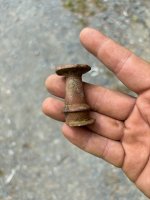ncFloridaBum
Jr. Member
- Dec 19, 2016
- 61
- 83
- Detector(s) used
- Five finger probe
- Primary Interest:
- All Treasure Hunting
I should be able to go online and purchase a coil with a pole that will connect directly to my iPhone. Instead the only options available are a $200 detector with WWII technology, or a $1000 detector with WWII technology + Crappy digital interface.
The companies that produce detectors won't make the leap because they aren't software based companies, and if the leap is made, they will quickly die off at the hands of software producers. This is an injustice to all of us. My phone packs more than enough processing capacity for a program that could give me a 3D image of the magnetic field being emitted from a coil.
I say we start a petition to show Apple, Microsoft, Sony, and other software companies that it would serve their financial interest to develop this.
The companies that produce detectors won't make the leap because they aren't software based companies, and if the leap is made, they will quickly die off at the hands of software producers. This is an injustice to all of us. My phone packs more than enough processing capacity for a program that could give me a 3D image of the magnetic field being emitted from a coil.
I say we start a petition to show Apple, Microsoft, Sony, and other software companies that it would serve their financial interest to develop this.







